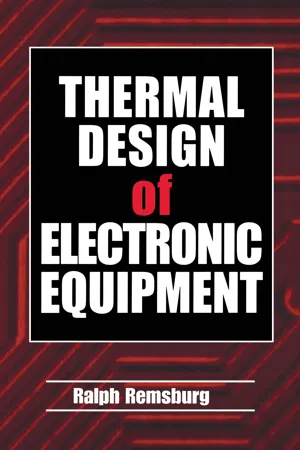
- 400 pages
- English
- ePUB (mobile friendly)
- Available on iOS & Android
Thermal Design of Electronic Equipment
About This Book
In a field where change and growth is inevitable, new electronic packaging problems continually arise. Smaller, more powerful devices are prone to overheating, causing intermittent system failures, corrupted signals, lower MTBF, and outright system failure. Since convection cooling is the heat transfer path most engineers take to deal with thermal problems, it is appropriate to gain as much understanding about the underlying mechanisms of fluid motion as possible.
Thermal Design of Electronic Equipment is the only book that specifically targets the formulas used by electronic packaging and thermal engineers. It presents heat transfer equations dealing with polyalphaolephin (PAO), silicone oils, perfluorocarbons, and silicate ester-based liquids. Instead of relying on theoretical expressions and text explanations, the author presents empirical formulas and practical techniques that allow you to quickly solve nearly any thermal engineering problem in electronic packaging.
Frequently asked questions
Information
1
Introduction to Thermal Design of Electronic Equipment
1.1 Introduction to the Modes of Heat Transfer in Electronic Equipment
1.1.1 Convection

| qc | = convective heat flow rate from the surface (W) |
| As | = surface area for heat transfer (m2) |
| Ts | = surface temperature (°C) |
| Tm | = coolant media temperature (°C) |
| hc | = coefficient of convective heat transfer (W/m2) |
1.1.2 Conduction
Table of contents
- Cover
- Half Title
- Title Page
- Copyright
- Preface
- Author
- Nomenclature and Symbology
- Table of Contents
- Chapter 1 Introduction to Thermal Design of Electronic Equipment
- Chapter 2 Formulas for Conductive Heat Transfer
- Chapter 3 Fluid Dynamics for Electronic Equipment
- Chapter 4 Convection Heat Transfer in Electronic Equipment
- Chapter 5 Radiation Heat Transfer in Electronic Equipment
- Chapter 6 Heat Transfer with Phase Change
- Chapter 7 Combined Modes of Heat Transfer for Electronic Equipment
- Appendix
- Index